|
Thera Wall Paintings Copies P. Nomikos Museum
The life-sized three-dimensional wall-paintings reproduced and exhibited here were sponsored by the "Thera Foundation, Petros M. Nomikos", and produced in France by Transfer Relief SA, using the Kodak Pathé process. Other similar Kodak Pathé commissions have been funded by the Getty Museum of California and the French government for the Egyptian tomb of Sennefer and the Lascaux Caves, respectively.
The manufacturing of these images involved a long, complex, and laborious process which necessitated the transfer of photographic emulsions onto a synthetic substrate that exactly replicates that of the original wall-painting plaster. This substrate was generated from a stereo-photogram of the original wall-painting in much that same way satellite imagery is used to render computerized topography in 3D.
Following the completion of the substrate, the photographic emulsion was then bonded to create the wall-paintings presented in the museum and shown in this album. Each image in the museum is rendered in a 1/1 scale, and has been stereo photographed using 20x25 cm. negatives so as to reduce peripheral image distortion and provide the very highest resolution. The results are exceptionally realistic and accurate, and this exhibition in Fira remains the only place where one can view, enjoy and study all of the wall-paintings of Thera.
For more detailed information about the technical and artistic aspects of the wall-paintings restoration please consult The Petros Nomikos Museum of Wall-Paintings of Akrotiri : A detailed reference for the inquisitive traveller.
Photos: Michael Tziotis
Select Page of the Album:
Click on any of the pictures to enlarge.
Animal Representations in the Theran wall-paintingsAt Akrotiri. animal representations on findings are numerous; almost any art form can be linked to themes in the natural world:
Antelopes:
Antelopes are not indigenous in the Cyclades. No archaeological evidence indicates this species could ever have lived naturally on the island. Either drawn from memory or copied from other images, pottery, seals, etc., the nearest live wild antelopes would have lived in Africa or the Near East. (Building Beta, room Beta 1: “Antelopes”)
Deer and Lions:
Deer, like antelopes, are not indigenous to the Cycladic islands; however several deer species can he found in mainland Greece. The deer is a recurring theme in Bronze Age art from neighboring societies; however, in Akrotiri its use is limited. Lions too are not indigenous to the Cyclades. Mythical and archaeological evidence indicate that lions may have been indigenous to areas of continental Greece; hence the myth of Hercules and the Nemean Lion, (West House, room 5. Miniature Frieze: “River”)
Monkeys:
Monkeys were probably imported from Africa, specifically Egypt; it is likely that they were used as domestic pets. Monkeys were very popular themes in the art of the time; however, until now, they have only been found on wall-paintings. Parallels to the Akrotiri “Monkeys” can be found in Crete, at Knossos, (Xeste 3. room 3a and 4, Sector Alpha: “Altar with Monkeys”\ Building Beta, room Beta 6: “Monkeys”)
Calves:
Calves were probably part of the local domesticated fauna; they are often found in Thera, in the company of humans. In other types of Bronze Age art, from neighboring societies, calves and other bovines frequently occur in the sacrificial context. (West House, room 5: “Miniature Frieze”: “Assembly on a hill and Shipwreck”. Building Beta, room Beta 6: “Cows”)
Ducks and Hunting Felines:
The most significant representation of these two species is in the “Miniature Frieze”. The flora and fauna indicate a lush riverbank, possibly alluding to the Nile. The spotted, lithe, hunting feline also alludes to an African context. A second representation shows a duck flying over a thicket of reeds, again indicating a fluval environment. (West House, room 5. “Miniature Frieze: River”, Xeste 3 room 3b: “Wild Duck”)
Swallows:
The kissing swallows are unlikely to be as romantic as we interpret them to be. The two swallows engaging each other beak-on-beak are probably males sparring for dominance. This motif, distinct to Thera, occurs frequently on wall-paintings and pottery. (Xeste 3. room 4 Building Complex Delta, room Delta 2 “Spring Fresco”)
Dolphins and other Fish:
The fisher boys hold two different species: the common mackerel with the silver belly and wavy back and the dolphin fish (mahi-mahi) with the yellow belly. Both of these are seasonal catches. Porpoise (commonly known as dolphins) are also shown playfully leaping between the bows of the flotilla in the “Miniature Frieze”. (West House Room 5: “Fishermen”, West House Room 5, “Miniature Frieze: Flotilla”)
Insects:
The butterfly occurs as a decorative element on the prow of the ships in the 'Miniature Frieze' and the dragonfly is often used in jewellery. (West House, Room 5, "Miniature Frieze: Flotilla", Xeste 3 Room 3a: “Mistress of Animals”).
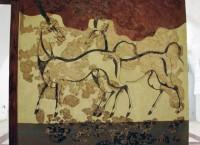
“Antelopes”
Building Beta, Room Beta 1, West wall, H. 2.75 / W. 2.00 m. North wall. H. 1.41 / W. 1.15 m.
Two antelopes are painted on a white background and framed by a red wave. Two more pairs of antelopes once covered the walls of this room. Upon the fourth wall was the “Boxing Boys”, framed by a similar red wave motif.It is unclear from the wall-paintings whether the animals depicted are gazelles or antelopes. Nevertheless, neither antelopes nor gazelles are indigenous to the Cycladic islands. Furthermore, no archaeological evidence indicates that either species could ever have lived naturally on the island. The inability to define the species is further testimony to the argument that the painter may never have seen either annual first-hand. As the nearest wild antelopes and gazelles lived either in Africa (Egypt) or the Near East, it is likely that these “hybrid” creatures were drawn from memory or copied from other images (pottery, seals, etc). For this reason, it is understandable that the antelopes' are not associated with any natural environment; instead, they seem to float without physical context.
Artistically, such fine line drawings are extremely difficult to render; the modern Greek painter Alekos Fassianos was impressed with the confidence and skill of the Theran artists. The ability to draw bold, fluid lines in a medium that does not afford erasing or re-drawing is a skill that is characteristic of both ancient and modern masters. |
|
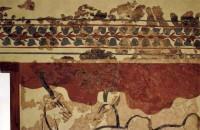
“Antelopes”, Decoration in the top zone of the wall-painting
Building Beta, Room Beta 1, West wall, H. 2.75 / W. 2.00 m. North wall. H. 1.41 / W. 1.15 m.
|
|
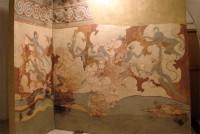
Monkeys
Building Beta Room Beta 6. North wall, H. 2.70 / W. 2.76 m. West wall, H. 2.70/W. 1.13 m.
On the northern and western walls of room Beta 6 in the upper store of Building Beta, blue monkeys are represented in a rocky habitat. The colors of the rocks and the landscape remind us or the island of Thera. The artist seems familiar with these animals. The climbing monkeys seem true-to-life, with their tails bent in an S-shape. Studies have shown that when monkeys move with an S-shaped tail, they do this in order to facilitate balance and grip.
Monkeys, indigenous to Egypt, held an important place in ancient Egyptian theology. Possibly brought to the island as gifts and pets, a monkey skull was found in Thera and is evidence of the artist's ability to study animals first-hand. Blue in color, with a white belly and groin, and a small round head with a pointed muzzle, the artist's monkeys present a convincing picture of reality.
The monkeys here are presented in their natural environment and are devoid of any anthropomorphic element, unlike in other wall-paintings in Akrotiri archaeological site. |
|
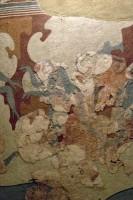
Monkeys (Detail of the North wall in the previous photo) |
|
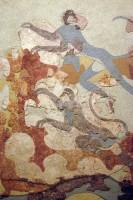
Monkeys (Another detail, this one from the West wall ) |
|
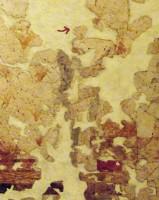
Monkey in the “Mistress of Animals” (Detail from the Wall-painting; the full fresco is shown in the relevant page)
Xeste 3, Room 3a, Northern Wall, H. 2.30 / W. 3.22 m
In this wall-painting, together with three saffron gatherers there is a fourth female figure, named the "Mistress of Animals". In front of her, climbing up the pedestal, there is this blue monkey holding outstretched a posy of crocuses. The monkey is the link between the woman offering crocuses and the "Mistress of Animals"; its inclusion in such a composition indicates that the monkey has acquired a symbolic meaning, directly related to the religious beliefs of the time.
Note: To help you distinguish the monkey we have drawn an arrow pointing to the back of is head. |
|

Deer and Lion
Detail from the "Miniature Frieze", "The River" section of it, shown in our previous Album page |
|
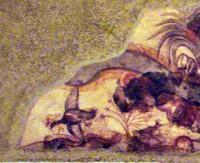
Ducks and Hunting Felines
West House, room 5: “Miniature Frieze, River”
The most significant representation of these species is in the “Miniature Frieze”. We have magnified one small portion of the River Miniature Frieze to show the duck depicted in it. |
|
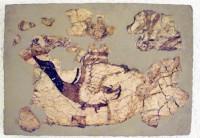
“Wild Duck”
Xeste 3, Room 3b, First Floor
Several representations of ducks are found on the wall-paintings at Akrotiri. Ducks are usually shown in their natural habitat, with the exception of the duck motif found on the necklace heads of the "Mistress of Animals".
Here, the bird is depicted in profile, with its wings folded upward. As only a few fragments of this wall-painting remain, we are unclear as to its exact context. |
|
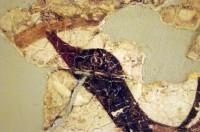
Wild Duck (Detail)
Xeste 3, Room 3b, First Floor
|
|
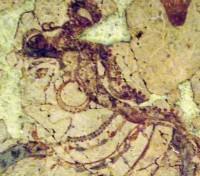
Ducks
“Mistress of Animals”, Xeste 3, Room 3a, Northern Wall. H. 2.30 / W. 3.22 m
The only representation of ducks outside their natural environment in the Theran wall-paintings is in one of the two necklaces around the neck of the “Mistress of Animals”.
Her second necklace is with a dragonfly motif. |
|
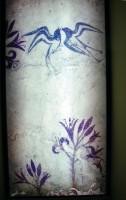
Swallows (Photo of a slide shown in the museum)
Xeste 3, room 4, Building Complex Delta, room Delta 2: “Spring Fresco” (Detail) |
|
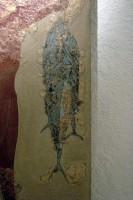
Dolphins and other Fish species
The three fish held by the fisherman in the wall-painting of "West House, Room 5, West wall", shown in the relevant "West House" page; their shape, size, and colors indicate them to be mackerel, Scomber Scombrus. Like the fish in the wall-painting, the mackerel have a characteristic fin structure, white bellies, and blue shiny backs.
Even though this wall-painting is poorly preserved, the surviving fragments are sufficient for restorers to accurately reconstruct and extrapolate the original image. |
|
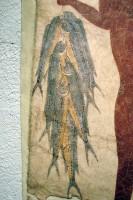
Dolphins and other Fish species
The seven fish held by the fisherman in the wall-painting of "West House, Room 5. North wall", shown in the relevant "West House" page;
The shape, size, and colors used to depict the fish indicate dolphin-fish, Coryphaena hippurus, also known as Mahi-Mahi. Like the fish in the wall-painting, the Mahi-Mahi have characteristic black fins, yellow bellies, and blue backs. |
|
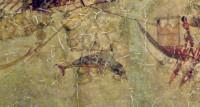
Dolphin (Detail of the relevant wall-painting in West House Room 5, “Miniature Frieze: Flotilla”)
Porpoise (commonly known as dolphins) are shown playfully leaping between the bows of the flotilla in the “Miniature Frieze”. |
|
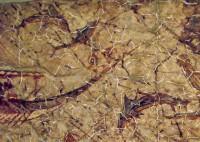
Dolphins
More dolphins from the same pre-named fresco. |
|
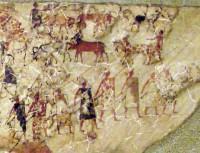
Calves
Large magnification of the "Miniature Frieze: Assembly on a hill and Shipwreck", depicting oxen and other animals (Horses, goats) |
|
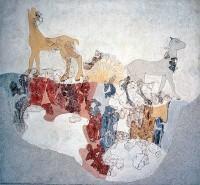
“Cows”
Building Beta, room Beta 6
Calves were probably part of the local domesticated fauna; they are often found in Thera, in the company of humans. In other types of Bronze Age art, from neighboring societies, calves and other bovines frequently occur in the sacrificial context. |
|
Select Page of the Album:
|
|
|
|



